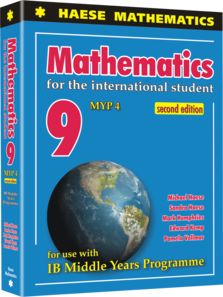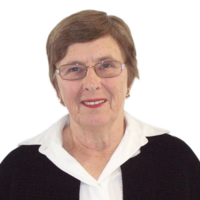About the Book
Year Published: 2014
Page Count: 560
ISBN: 978-1-921972-49-2 (9781921972492)
Online ISBN: 978-1-921972-50-8 (9781921972508)

Discontinued Editions
Year Published: 2014
Page Count: 560
ISBN: 978-1-921972-49-2 (9781921972492)
Online ISBN: 978-1-921972-50-8 (9781921972508)
| 1 | ALGEBRA | 11 | |
| A | Algebraic notation | 12 | |
| B | Evaluating algebraic expressions | 16 | |
| C | Collecting like terms | 19 | |
| D | Algebraic products | 20 | |
| Review set 1A | 21 | ||
| Review set 1B | 22 | ||
| 2 | INDICES | 23 | |
| A | Evaluating indices | 24 | |
| B | Index laws | 27 | |
| C | Scientific notation | 33 | |
| D | Rational indices | 38 | |
| Review set 2A | 40 | ||
| Review set 2B | 41 | ||
| 3 | SETS AND VENN DIAGRAMS | 43 | |
| A | Sets | 44 | |
| B | Special number sets | 46 | |
| C | Interval notation | 48 | |
| D | Complement of a set | 49 | |
| E | Venn diagrams | 51 | |
| F | Problem solving with Venn diagrams | 58 | |
| Review set 3A | 61 | ||
| Review set 3B | 62 | ||
| 4 | ALGEBRAIC EXPANSION | 65 | |
| A | The distributive law | 66 | |
| B | The product (a + b)(c + d) | 68 | |
| C | Difference of two squares | 70 | |
| D | Perfect square expansion | 72 | |
| E | Further expansion | 74 | |
| Review set 4A | 75 | ||
| Review set 4B | 76 | ||
| 5 | RADICALS | 77 | |
| A | Radicals and surds | 78 | |
| B | Simplifying radicals | 79 | |
| C | Simplest radical form | 82 | |
| D | Adding and subtracting radicals | 83 | |
| E | Multiplications involving radicals | 84 | |
| F | Division by radicals | 87 | |
| Review set 5A | 91 | ||
| Review set 5B | 91 | ||
| 6 | LINEAR EQUATIONS AND INEQUALITIES | 93 | |
| A | Linear equations | 94 | |
| B | Rational equations | 98 | |
| C | Problem solving | 101 | |
| D | Linear inequalities | 105 | |
| E | Solving linear inequalities | 107 | |
| Review set 6A | 111 | ||
| Review set 6B | 111 | ||
| 7 | MEASUREMENT | 113 | |
| A | Length and perimeter | 114 | |
| B | Area | 119 | |
| C | Surface area | 125 | |
| D | Volume | 131 | |
| E | Capacity | 140 | |
| Review set 7A | 143 | ||
| Review set 7B | 145 | ||
| 8 | COORDINATE GEOMETRY | 147 | |
| A | The distance between two points | 149 | |
| B | Midpoints | 152 | |
| C | Gradient | 154 | |
| D | Parallel and perpendicular lines | 159 | |
| E | The equation of a line | 162 | |
| F | Graphing lines from equations | 165 | |
| G | Finding the equation of a line | 167 | |
| Review set 8A | 170 | ||
| Review set 8B | 172 | ||
| 9 | QUADRATIC FACTORISATION | 173 | |
| A | Removing common factors | 174 | |
| B | Difference of two squares factorisation | 175 | |
| C | Perfect square factorisation | 177 | |
| D | Factorising expressions with four terms | 178 | |
| E | Factorising quadratic trinomials | 179 | |
| F | Factorising ax² + bx + c, a ≠ 1 | 182 | |
| Review set 9A | 184 | ||
| Review set 9B | 184 | ||
| 10 | STATISTICS | 187 | |
| A | Types of data | 189 | |
| B | Discrete numerical data | 190 | |
| C | Continuous numerical data | 195 | |
| D | Measuring the centre of a data set | 197 | |
| E | Cumulative data | 204 | |
| F | Measuring the spread of a data set | 206 | |
| G | Box-and-whisker plots | 209 | |
| Review set 10A | 211 | ||
| Review set 10B | 213 | ||
| 11 | ALGEBRAIC FRACTIONS | 215 | |
| A | Evaluating algebraic fractions | 216 | |
| B | Simplifying algebraic fractions | 217 | |
| C | Multiplying algebraic fractions | 224 | |
| D | Dividing algebraic fractions | 225 | |
| E | Adding and subtracting algebraic fractions | 226 | |
| Review set 11A | 228 | ||
| Review set 11B | 229 | ||
| 12 | FINANCIAL MATHEMATICS | 231 | |
| A | Business calculations | 232 | |
| B | Appreciation and depreciation | 237 | |
| C | Simple interest | 239 | |
| D | Compound interest | 243 | |
| E | Personal loans | 246 | |
| Review set 12A | 249 | ||
| Review set 12B | 250 | ||
| 13 | TRIGONOMETRY | 251 | |
| A | Labelling right angled triangles | 252 | |
| B | The trigonometric ratios | 253 | |
| C | Finding side lengths | 256 | |
| D | Finding angles | 258 | |
| E | Problem solving with trigonometry | 260 | |
| F | Bearings | 265 | |
| G | 3-dimensional problem solving | 268 | |
| Review set 13A | 269 | ||
| Review set 13B | 271 | ||
| 14 | PROBABILITY | 275 | |
| A | Experimental probability | 277 | |
| B | Probabilities from tabled data | 278 | |
| C | Sample space | 280 | |
| D | Theoretical probability | 282 | |
| E | Using 2-dimensional grids | 284 | |
| F | Compound events | 286 | |
| G | Using tree diagrams | 290 | |
| H | Sampling with and without replacement | 293 | |
| I | Probabilities from Venn diagrams | 296 | |
| J | Expectation | 298 | |
| Review set 14A | 300 | ||
| Review set 14B | 301 | ||
| 15 | FORMULAE | 303 | |
| A | Formula construction | 304 | |
| B | Substituting into formulae | 307 | |
| C | Rearranging formulae | 310 | |
| D | Rearrangement and substitution | 312 | |
| Review set 15A | 315 | ||
| Review set 15B | 316 | ||
| 16 | TRANSFORMATION GEOMETRY | 319 | |
| A | Translations | 322 | |
| B | Reflections | 326 | |
| C | Rotations | 332 | |
| D | Enlargements and reductions | 335 | |
| Review set 16A | 341 | ||
| Review set 16B | 343 | ||
| 17 | COMPARING NUMERICAL DATA | 345 | |
| A | Comparing the measures of centre and spread | 346 | |
| B | Comparing data sets graphically | 348 | |
| C | Parallel box-and-whisker plots | 352 | |
| Review set 17A | 355 | ||
| Review set 17B | 356 | ||
| 18 | QUADRATIC EQUATIONS | 359 | |
| A | Equations of the form x² = k | 361 | |
| B | The Null Factor law | 362 | |
| C | Solution by factorisation | 363 | |
| D | Completing the square | 365 | |
| E | Problem solving | 368 | |
| Review set 18A | 371 | ||
| Review set 18B | 371 | ||
| 19 | SIMULTANEOUS EQUATIONS | 373 | |
| A | Graphical solution | 374 | |
| B | Solution by substitution | 377 | |
| C | Solution by elimination | 378 | |
| D | Problem solving | 380 | |
| E | Non-linear simultaneous equations | 384 | |
| Review set 19A | 386 | ||
| Review set 19B | 387 | ||
| 20 | CONGRUENCE AND SIMILARITY | 389 | |
| A | Congruence of figures | 390 | |
| B | Congruent triangles | 391 | |
| C | Proof using congruence | 395 | |
| D | Similarity | 397 | |
| E | Problem solving | 402 | |
| F | Areas of similar objects | 405 | |
| G | Volumes of similar objects | 407 | |
| Review set 20A | 410 | ||
| Review set 20B | 411 | ||
| 21 | QUADRATIC FUNCTIONS | 415 | |
| A | Quadratic functions | 416 | |
| B | Transformations to sketch quadratics | 422 | |
| C | Axes intercepts | 426 | |
| D | Sketching quadratics from their axes intercepts | 429 | |
| Review set 21A | 430 | ||
| Review set 21B | 431 | ||
| 22 | DEDUCTIVE GEOMETRY | 433 | |
| A | Deductive geometry | 436 | |
| B | Circle theorems | 440 | |
| C | The midpoint theorem | 447 | |
| Review set 22A | 450 | ||
| Review set 22B | 451 | ||
| 23 | EXPONENTIAL AND RATIONAL FUNCTIONS | 453 | |
| A | Exponential equations | 454 | |
| B | Exponential functions | 455 | |
| C | Graphs of exponential functions | 456 | |
| D | Growth | 459 | |
| E | Decay | 461 | |
| F | Simple rational functions | 464 | |
| Review set 23A | 467 | ||
| Review set 23B | 468 | ||
| 24 | PROPORTION | 469 | |
| A | Direct proportion | 470 | |
| B | Powers in direct proportions | 474 | |
| C | Inverse proportion | 478 | |
| Review set 24A | 482 | ||
| Review set 24B | 483 | ||
| 25 | NON-RIGHT ANGLED TRIANGLE TRIGONOMETRY | 485 | |
| A | The unit circle | 486 | |
| B | The area of a triangle | 490 | |
| C | The sine rule | 493 | |
| D | The cosine rule | 497 | |
| E | Problem solving using the sine and cosine rules | 500 | |
| Review set 25A | 502 | ||
| Review set 25B | 503 | ||
| 26 | VECTORS | 505 | |
| A | Vector representation | ONLINE | |
| B | The length of a vector | ONLINE | |
| C | Equal vectors | ONLINE | |
| D | Vector addition | ONLINE | |
| E | Multiplying vectors by a number | ONLINE | |
| F | Vector subtraction | ONLINE | |
| G | The direction of a vector | ONLINE | |
| H | Problem solving by vector addition | ONLINE | |
| Review set 26A | ONLINE | ||
| Review set 26B | ONLINE | ||
| 27 | LOGIC | 506 | |
| A | Propositions | ONLINE | |
| B | Compound statements | ONLINE | |
| C | Constructing truth tables | ONLINE | |
| Review set 27A | ONLINE | ||
| Review set 27B | ONLINE | ||
| ANSWERS | 507 | ||
| INDEX | 559 | ||

Michael completed a Bachelor of Science at the University of Adelaide, majoring in Infection and Immunity, and Applied Mathematics. He studied laminar heat flow as part of his Honours in Applied Mathematics, and finished a PhD in high speed fluid flows in 2001. He has been the principal editor for Haese Mathematics since 2008.
What motivates you to write mathematics books?
My passion is for education as a whole, rather than just mathematics. In Australia I think it is too easy to take education for granted, because it is seen as a right but with too little appreciation for the responsibility that goes with it. But the more I travel to places where access to education is limited, the more I see children who treat it as a privilege, and the greater the difference it makes in their lives. But as far as mathematics goes, I grew up with mathematics textbooks in pieces on the kitchen table, and so I guess it continues a tradition.
What do you aim to achieve in writing?
I think a few things:
What interests you outside mathematics?
Lots of things! Horses, show jumping and course design, alpacas, badminton, running, art, history, faith, reading, hiking, photography ....

Sandra completed a Bachelor of Science at the University of Adelaide, majoring in Pure Mathematics and Statistics. She taught at Underdale High School and Westminster School before founding Haese and Harris Publications (now Haese Mathematics), together with husband Robert (Bob) and colleague Kim Harris.
What drew you to the field of mathematics?
I always found mathematics the easiest subject at school. I’m not sure why. I intended to study Chemistry at university, but found I didn’t enjoy it as much as I thought I would – so I came back to mathematics, and have been involved with it ever since.
What motivated you to switch from teaching to writing mathematics books?
Bob used to write notes for his class. Other teachers at the school used the notes, then teachers at other schools started asking for them. Eventually Bob said, “Well, I might as well start writing textbooks!”
Initially, I was proofreading. As the workload increased, I began editing as well as proofreading. It just gradually became a full-time job, between writing material, editing and proofreading it, and then distributing the books. These days, Michael does the editing and I do proofreading and audio.
How has the field of textbook publishing changed in the years since you started?
When we started, text was typed and worked solutions were handwritten. Bob would draw any graphics by hand.
We moved to typesetting, but writing a mathematics textbook with the printing tools available presented its own difficulties. For example, symbols had to be copied, cut and pasted by hand onto the original pages, which was very tedious and time-consuming! Fractions were also problematic: we would type a line containing all the numerators, and then a line underneath for all the denominators.
Now it’s all done by computers, which is very much easier, and quicker!
What interests you outside mathematics?
I own a few alpacas. I enjoy my garden - I don’t do much in it, but I enjoy it! I like listening to music; mainly classical, but I enjoy other genres as well.
I really love to travel. The scenery, the history of a place, its architecture, its art – all of those things fascinate me. As a result I also enjoy photography; I like taking pictures of the things I’ve seen and places I’ve experienced.

Mark has a Bachelor of Science (Honours), majoring in Pure Mathematics, and a Bachelor of Economics, both of which were completed at the University of Adelaide. He studied public key cryptography for his Honours in Pure Mathematics. He started with the company in 2006, and is currently the writing manager for Haese Mathematics.
What got you interested in mathematics? How did that lead to working at Haese Mathematics?
I have always enjoyed the structure and style of mathematics. It has a precision that I enjoy. I spend an inordinate amount of my leisure time reading about mathematics, in fact! To be fair, I tend to do more reading about the history of mathematics and how various mathematical and logic puzzles work, so it is somewhat different from what I do at work.
How did I end up at Haese Mathematics?
I was undertaking a PhD, and I realised that what I really wanted to do was put my knowledge to use. I wanted to pass on to others all this interesting stuff about mathematics. I emailed Haese Mathematics (Haese and Harris Publications as they were known back then), stating that I was interested in working for them. As it happened, their success with the first series of International Baccalaureate books meant that they were looking to hire more people at the time. I consider myself quite lucky!
What are some interesting things that you get to do at work?
On an everyday basis, it’s a challenge (but a fun one!) to devise interesting questions for the books. I want students to have questions that pique their curiosity and get them thinking about mathematics in a different way. I prefer to write questions that require students to demonstrate that they understand a concept, rather than relying on rote memorisation.
When a new or revised syllabus is released for a curriculum that we write for, a lot of work goes into devising a structure for the book that addresses the syllabus. The process of identifying what concepts need to be taught, organising those concepts into an order that makes sense from a teaching standpoint, and finally sourcing and writing the material that addresses those concepts is very involved – but so rewarding when you hold the finished product in your hands, straight from the printer.
What interests you outside mathematics?
Apart from the aforementioned recreational mathematics activities, I play a little guitar, and I enjoy playing badminton and basketball on a social level.


Pamela completed a Bachelor of Science with Honours at the University of East Anglia in the UK. She has also completed a Postgraduate Certificate of Education at the Cambridge Institute of Education.
When did you start teaching, and where have you taught?
I started teaching in 1973 at the Hewett School in Norwich, and taught all levels up to and including A level Pure, A Level Applied and S level Mathematics. I was also Pastoral Tutor to Year 11. I was then recruited by the British Council to be Head of Mathematics and Science at the English High School for Girls in Istanbul, where I stayed for 6 years. In 1985, I came to Frankfurt International School. I became Head of the Mathematics Department and have taught IB Mathematics at all levels. I was also elected by the faculty to the Board of Trustees of the school where I served for more than 6 years.
How did you come to collaborate with Haese Mathematics?
When Haese Mathematics brought out their first edition of Mathematics for the International Student MYP5, we bought some copies to have a look at. Shortly after, I received an email from their marketing department asking whether I would be willing to give them my evaluation of the book, which I did. Ray O'Farrell, responsible for marketing, got in touch, and I mentioned to him the problems that schools like ours were having in finding a set of suitable maths textbooks for grade 6-10 which would be rigorous enough to prepare students for IB. I also told him that we had even joked about contacting a publisher to produce such a series. Famous last words! This was the point where Ray asked whether I would be willing, in principle, to work with Haese Mathematics to produce such a series. I agreed....... and the rest is history!
What interests you outside mathematics?
Outside school, when I'm not looking after my family, I enjoy going to the theatre, both watching and acting. I love entertaining friends (and being entertained!), walking, and I read far too many crime/espionage novels. I also love travelling and (trying to speak) foreign languages; at the moment I am learning Japanese.
A complete electronic copy of the textbook, with interactive, animated, and/or printable extras.
Animated worked examples with step-by-step, voiced explanations.
Projects to guide Global Context work.
Graphics Calculator Instructions
For Casio fx-9860G Plus, Casio fx-CG20, TI-84 Plus, and TI-nspire

This book is available on electronic devices through our Snowflake learning platform. This book includes 15 months of Snowflake access, featuring a complete electronic copy of the textbook.
Where relevant, Snowflake features include interactive geometry, graphing, and statistics software, demonstrations, games, spreadsheets, and a range of printable worksheets, tables, and diagrams. Teachers are provided with a quick and easy way to demonstrate concepts, and students can discover for themselves and re-visit when necessary.
This book offers SELF TUTOR for every worked example. On the electronic copy of the textbook, access SELF TUTOR by clicking anywhere on a worked example to hear a step-by-step explanation by a teacher. This is ideal for catch-up and revision, or for motivated students who want to do some independent study outside school hours.
The International Baccalaureate Middle Years Programme focuses teaching and learning through six Global Contexts:
|
|
|
|
|
|
There are 6 projects included in this book, one for each of the Global Contexts. Each project is divided into factual, conceptual, and debatable questions to help guide the unit of work.
Projects are accompanied by a general descriptor and a task-specific descriptor for each of the relevant assessment criteria, to help teachers assess the unit of work.
The Global Contexts are intended as a focus for developing connections between different subject areas in the curriculum, and to promote an understanding of the interrelatedness of different branches of knowledge and the coherence of knowledge as a whole.
Graphics calculator instructions for Casio fx-9860G Plus, Casio fx-CG20, TI-84 Plus, and TI-nspire are included with this textbook. The textbook will either have comprehensive instructions at the start of the book, specific instructions available from icons located throughout, or both. The extensive use of graphics calculators and computer packages throughout the book enables students to realise the importance, application, and appropriate use of technology.
Register your interest for information related to Haese Mathematics products